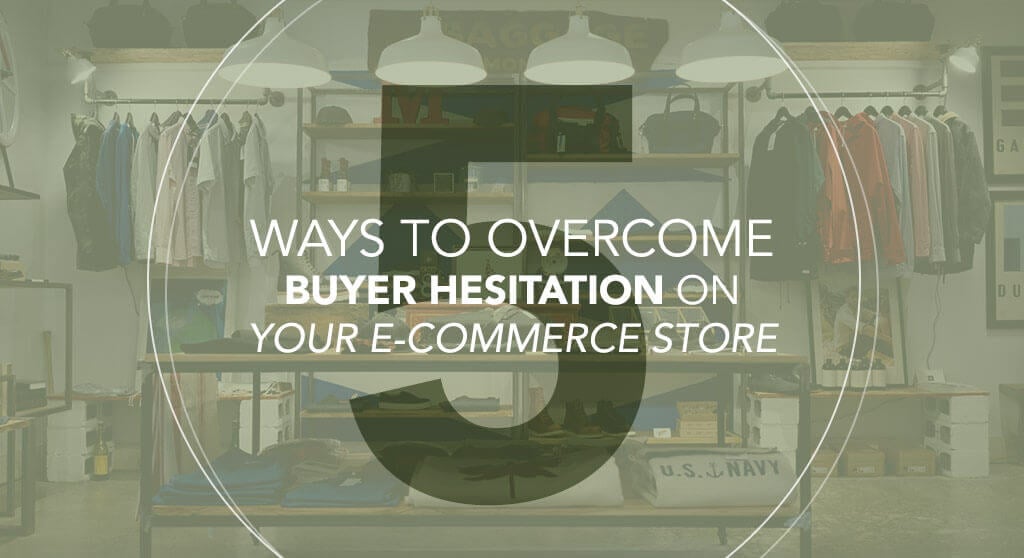
Here’s your how to guide reluctant shoppers all the way to checkout.
Many e-commerce businesses face a similar problem: they’re attracting lots of visitors, but not enough of them are buying. We call this reluctance “buyer hesitation,” and the good news is that you can address it on your site. Here’s how.
1. What’s the deal-breaker?
One of the first steps to overcoming buyer hesitation is understanding where their reluctance comes from. What’s causing them to abandon their carts—or not to add products to their cart in the first place? This is where tracking user behavior can come in real handy. Try to find where in the buying process your customers are turning away. Is it before they add any items to the cart, or sometime within the checkout process?
If your visitors won’t even add an item to the cart, you probably have an issue with either the price or the product itself. On the other hand, if you have a high cart abandonment rate, then the problem may have something to do with the checkout process itself. Are your shipping rates too high, or is your form too complex? User data will help you find the answer.
2. Use social proof.
Sometimes, you have to rely on previous customers to sell your product for you. This is what the concept of “social proof” is all about. Most customers are reluctant to take your word at face value, because they instinctively recognize that you’re not an unbiased subject. However, when your previous customers speak on your behalf, their experience carries weight.
Social proof comes in many forms, but testimonials, case studies, and reviews are the most common. The best strategy is to allow customer reviews from social media to publicize to your website. While many businesses are hesitant to do this for fear of a negative review landing on their page, studies show that the occasional low score lends greater credibility to your business. Customers value transparency, so showing that you have nothing to hide wins over trust.
3. Create a sense of urgency.
Scarcity is a big motivator for many visitors. Not only does in increase the perceived value of the product, but it encourages buyers to act while they still have a chance. Let your customers know if you’re running out of stock on a certain item. This can be a simple “Hurry, only a few left!” near the “buy now” button, but a countdown showing an exact number is more effective.
You can create a similar effect by offering a “limited run” of a product, which heightens the demand. Think about Starbucks and their pumpkin spice lattes: would they be as popular if customers could buy them year round? By artificially limiting the supply, Starbucks boosts the demand. And by changing their seasonal offers, they keep the demand up year round.
Similarly, you can run a sale or offer a coupon with a specific expiry date. Many websites will offer new visitors a special discount code that is only valid for twenty-four hours. However, sales have limited effectiveness. Offer them too often, and your visitors will learn not to shop unless there’s a sale on. It also teaches your visitors to devalue your product as they come to expect it for the sale price rather than its full retail value. Your visitors may even conclude that your sale isn’t genuine, and that you’ve hiked up the list price just so you can make the sale price look good. Needless to say, that will damage your bottom line.
4. Offer a good returns policy.
Online shopping has a lot of advantages over brick-and-mortar institutions. To begin, we no longer have to rely on customers walking into our store to market to them. Instead, we can reach them in their homes at any hour of the day. And while the customer’s ability to research competing products makes the competition tougher, it also gives you the opportunity to demonstrate that your product is the best.
That said, the biggest disadvantage to most e-commerce stores is that customers don’t have the opportunity to see the product in person before they buy. It took most clothing retailer years to overcome this barrier, and there are some items that many buyers still won’t purchase online without an iron-clad returns policy.
Warby Parker is a top example of this strategy. Glasses are one of the hardest products to sell online, particularly with all the challenges of making sure the prescription lenses work. But their home try-on system as well as a generous returns policy have helped them become a top brand in the eyewear industry.
5. Let them try it for free.
The “try for free” model is all over the Internet, and for good reason: it works. Almost anyone will try something out because it comes with no commitment. This works best for online subscriptions and SaaS models. It’s also worked for various clothing suppliers, with a policy that allows subscribers to try clothes on at home, pay for what they want to keep, and return everything else.
Shipping is also a huge part of this. Many businesses struggle to compete with Amazon’s free shipping policy on orders over $25 (or any order for Prime members). That’s a hard offer to beat, but it’s part of what made Amazon a successful company. Offering free shipping on orders that cross a certain price threshold can encourage many of your customers to buy a little extra just to meet the requirements.
It’s all about trust.
A healthy customer relationship is all about building trust with your consumer. The first purchase will always be the hardest to land. If you can convince someone to buy from you once, their experience with your company will be the biggest factor in whether or not they decide to buy from you again. Creating and retaining that trust will be down to you, your product, and your customer service department.





